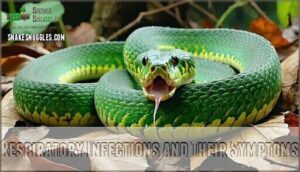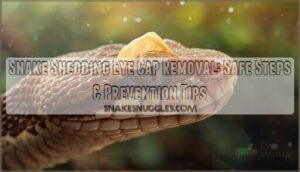This site is supported by our readers. We may earn a commission, at no cost to you, if you purchase through links.
 If you’re wondering how to treat snake lethargy, start by checking your snake’s environment.
If you’re wondering how to treat snake lethargy, start by checking your snake’s environment.
Temperature and humidity issues are often the culprits behind sluggish behavior.
Verify that your heating sources are working properly and temperatures match your species’ requirements.
Provide fresh water and a comfortable hiding spot.
Watch for other symptoms like breathing difficulties, mouth rot, or unusual discharge.
Don’t force-feed a lethargic snake, but monitor their condition closely.
Sometimes lethargy signals serious health problems like respiratory infections or parasites that need immediate attention.
While environmental fixes solve many cases, persistent lethargy warrants professional help.
The key is knowing when minor adjustments aren’t enough, and it’s crucial to identify when serious health problems or respiratory infections are present, to ensure the snake receives the necessary care, and to understand that environmental fixes may not always be sufficient.
Table Of Contents
- Key Takeaways
- Identifying Signs of Snake Lethargy
- Assessing Environmental Factors Affecting Snake Health
- Immediate Steps to Aid a Lethargic Snake
- Common Illnesses Causing Snake Lethargy
- When to Seek Veterinary Care
- Treatment Options for Lethargic Snakes
- Long-Term Care and Prevention of Lethargy
- Frequently Asked Questions (FAQs)
- What to do if my snake is lethargic?
- How to rehydrate your snake?
- What does lethargy look like in snakes?
- How to make your snake more active?
- What to do if your snake is lethargic?
- How can I make my snake more active?
- How do you rehydrate a snake?
- How do you feed a weak snake?
- How long does snake lethargy typically last?
- Can snake lethargy be contagious to other snakes?
- Conclusion
Key Takeaways
- Check your snake’s environment first – You’ll need to verify temperatures (88-95°F basking spot, 75-80°F cool side) and humidity levels (50-70%) since environmental issues cause most lethargy cases
- Watch for serious warning signs – Don’t ignore breathing difficulties, discharge, sunken eyes, or complete unresponsiveness, as these indicate emergency situations requiring immediate veterinary care
- Provide supportive care while monitoring – You can offer warm soaks for hydration, ensure fresh water access, and create comfortable hiding spots, but avoid force-feeding and document any changes
- Know when to call a professional – If environmental fixes don’t improve your snake’s condition within days, or if you notice weight loss, neurological symptoms, or persistent refusal to eat, you’ll need a reptile veterinarian’s expertise
Identifying Signs of Snake Lethargy
Recognizing when your snake isn’t feeling well can save its life, but the signs aren’t always obvious.
You’ll need to watch for subtle changes in behavior and physical appearance that signal something’s wrong, which can be a complete concept to understand for any snake owner.
Common Causes of Snake Lethargy
Behind every sluggish snake lies a specific trigger.
Your pet’s lethargy typically stems from three main culprits that directly impact their energy levels:
- Temperature extremes: Too hot or cold environments disrupt metabolism and natural activity patterns
- Humidity problems: Incorrect moisture levels cause dehydration and stress-related inactivity
- Underlying diseases: Respiratory infections, parasites, or diet deficiencies drain your snake’s energy
Snakes may also become inactive due to environmental or stress factors.
Distinguishing Normal Vs. Abnormal Lethargy
Understanding snake lethargy patterns helps you catch problems early.
Normal lethargy happens during brumation signs or shedding lethargy cycles, lasting days not weeks.
Your snake’s activity baselines matter – some species naturally rest more.
Watch for concerning behavioral patterns like refusing favorite foods beyond typical anorexia duration, remaining motionless when handled, or showing lethargic snake symptoms alongside breathing changes.
Associated Symptoms to Watch For
Snake lethargy rarely travels alone—it brings concerning companions that signal deeper problems.
Watch for these critical dehydration signs and weakness indicators that often accompany lethargic snake symptoms.
- Sunken eyes and wrinkled skin – Clear dehydration markers requiring immediate attention
- Breathing difficulties or nasal discharge – Respiratory issues demanding urgent care
- Weight loss with prominent spine – Advanced illness requiring veterinary intervention
Physical symptoms like dull scales, incomplete sheds, or mouth discharge reveal lethargy patterns linked to serious conditions.
These sick snake signs don’t lie—they’re your snake’s distress signals.
Behavioral Changes Indicating Illness
Your snake’s personality can change when it’s sick.
Watch for stress signs like constant hiding when your snake usually explores. Notice if your regular eater suddenly refuses food – this snake behavior shift signals trouble.
Look for unusual breathing patterns, activity levels dropping, or skin changes. These health indicators help you spot snake lethargy causes early.
Assessing Environmental Factors Affecting Snake Health
Environmental factors control your snake’s energy levels more than you might think.
Getting the temperature, humidity, lighting, and habitat setup right can make the difference between a sluggish snake and an active, healthy one.
Optimal Temperature and Humidity Levels
Temperature control makes or breaks your snake’s health. When temperatures drop below 60°F, your pet becomes sluggish and stops eating.
Here’s your action plan:
- Temperature Gradients: Create a warm basking spot (88-95°F) and cool side (75-80°F) using under-tank heaters
- Humidity Control: Maintain 50-70% humidity with water bowls, misting, or humidity chambers
- Moisture Management: Use proper substrate and monitor with hygrometers for consistent thermal cycling
Effective temperature management involves using a temperature controller to regulate the environment.
Importance of Proper UV Lighting
Beyond getting temperatures right, your snake needs proper UV lighting to stay healthy and active.
UVB lighting boosts vitamin D3 production by 3.4 times, helping calcium absorption and preventing metabolic bone disease.
Set up light cycles that mimic natural photoperiods – this regulates your snake’s internal clock and reduces lethargy.
Quality lighting systems with appropriate UV index levels keep your reptile alert and thriving, and proper reptile lighting is essential for maintaining the overall health of your snake.
Maintaining a Clean and Stress-Free Habitat
Once you’ve set up proper lighting, keeping the habitat clean and stress-free is just as important.
A spotless enclosure isn’t just for looks—it’s your snake’s comfort zone.
Focus on:
- Regular Enclosure Cleaning to prevent illness
- Smart Habitat Design with multiple snake hiding spots
- Substrate Selection that supports easy cleaning and Humidity Control
- Stress Reduction through quiet, secure spaces
Good snake enclosure maintenance and stress management go a long way.
Impact of Diet on Snake Activity
Your feeding habits directly affect your snake’s energy. Proper nutrition and meal frequency prevent lethargy while overfeeding causes sluggishness.
| Age Group | Feeding Schedule | Prey Size |
|---|---|---|
| Juvenile | Every 5-7 days | 10-15% body weight |
| Adult | Every 10-14 days | 5-10% body weight |
| Senior | Every 14-21 days | 5% body weight |
| Breeding females | Every 7-10 days | 10-15% body weight |
| Post-illness recovery | Every 7 days | 5-8% body weight |
Dietary supplements aren’t usually needed with whole prey. Watch for appetite management issues – sudden refusal often signals illness requiring snake lethargy treatment.
Immediate Steps to Aid a Lethargic Snake
When you spot a lethargic snake, quick action can make the difference between recovery and serious health complications.
Your first steps should focus on creating the right environment and closely watching your snake’s response to these changes, which can involve closely watching to ensure the best outcome.
Providing a Warm and Comfortable Environment
Your lethargic snake needs warmth to kickstart recovery. Create a temperature gradient with a basking spot at 88-95°F and a cooler side at 75-80°F using heat lamps or ceramic heaters. Humidity management should maintain 50-70% levels for ideal comfort zones.
Key enclosure design elements for snake lethargy treatment:
- Install multiple thermometers to monitor heat gradients accurately
- Position heating elements on one side for proper temperature control
- Add secure hiding spots on both warm and cool sides
This snake enclosure setup meets your pet’s snake temperature requirements while reducing stress-induced lethargy. Proper heat lamp systems are essential for maintaining the desired temperature gradient.
Offering Hydration Through Water Baths
Once you’ve warmed up the enclosure, water therapy becomes your next move.
Fill a shallow container with water heated to 85-90°F – just enough to cover your snake’s body.
These hydration methods help combat dehydration, a common culprit behind snake lethargy.
Let your snake soak for 15-30 minutes while you supervise.
This gentle snake soaking technique boosts fluid intake and often perks up sluggish reptiles surprisingly well.
Encouraging Food Intake in Weak Snakes
When your snake won’t eat, don’t panic. Try these proven Food Stimulation techniques to encourage Weak Snake Feeding:
- Offer smaller, warmed prey items for easier digestion
- Use snake feeding techniques like scenting with favorite prey
- Try Appetite Boosters through gentle handling and environmental enrichment
- Consider Nutrient Supplements mixed with liquid food
- Hand-feed with tweezers if your lethargic snake shows minimal interest
Remember, Force Feeding should only be done by veterinary professionals.
Understanding optimal snake care is vital for addressing appetite loss and promoting overall health in snakes.
Monitoring and Recording Snake’s Condition
Creating a snake diary becomes your best friend once you’ve encouraged eating.
Track your pet’s weight, shedding cycles, appetite, and bathroom habits weekly.
This health tracking system helps you spot behavior changes before they become serious problems.
Record keeping gives you concrete data for snake health checkups.
Think of it as detective work – you’re gathering clues about your snake’s condition.
These snake observations will make condition monitoring easier and help your vet diagnose issues faster.
Common Illnesses Causing Snake Lethargy
When your snake won’t move and barely responds to touch, several serious illnesses could be the culprit.
Respiratory infections, digestive blockages, parasites, and bone disease are the most common health problems that drain your pet’s energy and leave them listless, with respiratory infections being particularly concerning.
Respiratory Infections and Their Symptoms
Most respiratory infections start with subtle signs before becoming serious health threats.
Watch for wheezing, nasal discharge, or open-mouth breathing – these indicate bacterial or viral respiratory problems.
Your snake might also make gurgling sounds or show excess mucus around the nostrils.
Respiratory issues cause significant lethargy because breathing difficulties drain energy.
Poor husbandry often triggers these lung diseases, making infection control essential for recovery.
Understanding respiratory infection symptoms is key to identifying the underlying cause of lethargy in snakes.
Digestive Issues and Gastrointestinal Impactions
Could your snake’s belly troubles be causing that worrying lethargy? Digestive issues and gastrointestinal impactions create serious problems when feeding issues or intestinal blockage occur.
Key signs of impaction causes affecting gut health:
- Lack of bowel movements for weeks
- Unusual swelling in the midsection
- Loss of appetite and lethargy
Proper diet and hydration keep your snake’s digestive enzymes working smoothly, preventing snake lethargy from digestive issues.
Parasitic Infestations and Their Effects
Tiny invaders can drain your snake’s energy faster than you’d expect. Mite infestations and internal parasites are sneaky culprits behind lethargy.
Snake mites appear as moving red specks, causing excessive soaking behavior. Internal parasites like roundworms trigger weight loss and digestive issues.
Tiny parasites steal your snake’s energy before you notice they’re there.
Regular parasite screening helps catch these problems early. Watch for unusual scratching, incomplete sheds, or changes in appetite.
Parasitic infestations weaken your snake’s immune system, making them vulnerable to other infections. Quick parasite control prevents serious health complications and gets your serpent back to normal activity levels, ensuring a return to normal activity.
Metabolic Bone Disease and Nutritional Deficiencies
Beyond parasite problems, poor nutrition can zap your snake’s energy just as effectively. Metabolic bone disease stems from calcium deficiency and inadequate vitamin D3, creating a perfect storm for lethargy.
When nutrient absorption fails, your snake’s bone health deteriorates rapidly.
Signs your snake needs better nutrition:
- Soft, bendable bones that feel rubbery to touch
- Muscle tremors and difficulty supporting body weight
- Reluctance to climb or move around their enclosure
- Poor appetite leading to visible weight loss
Malnutrition doesn’t happen overnight, but once metabolic bone disease takes hold, your snake becomes a shadow of its former self. Think of calcium like fuel for their engine – without it, everything slows down and breaks down.
When to Seek Veterinary Care
Knowing when your snake needs professional help can mean the difference between a full recovery and a serious health crisis.
You should contact a reptile veterinarian immediately if your snake shows severe lethargy combined with breathing difficulties, won’t eat for weeks, or displays neurological symptoms like abnormal positioning.
Recognizing Emergency Situations
Some snake illnesses develop into life-threatening Emergency Signs that demand immediate Veterinary Intervention.
When your lethargic snake shows Critical Care warning signals, you’ve got minutes, not hours.
These snake lethargy red flags mean your pet needs professional help fast!
| Emergency Signs | What It Looks Like | Action Needed |
|---|---|---|
| Respiratory distress | Open-mouth breathing, wheezing | Snake Rescue – call vet now |
| Severe dehydration | Sunken eyes, wrinkled skin | Urgent Treatment required |
| Complete collapse | Flaccid body, unresponsive | Emergency vet immediately |
Finding a Qualified Reptile Veterinarian
When hunting for a qualified reptile vet, start with the Association of Reptilian and Amphibian Veterinarians directory for certified specialists.
Check vet credentials, read clinic reviews, and ask local herpetological societies for veterinary referrals.
Look for exotic vets with snake experience and emergency care availability—your scaly friend deserves proper reptile specialists.
Preparing for The Veterinary Visit
Once you’ve found your reptile vet, gather your snake’s medical history and recent photos showing symptoms.
Document feeding schedules, temperature logs, and behavioral changes. Create a PreVisit Checklist including secure Snake Transport container with proper ventilation.
Pack recent shed skins and fecal samples if available. This Emergency Prep guarantees your veterinary examination provides accurate snake lethargy diagnosis and effective snake illness treatment for snake health problems.
Importance of Early Intervention
Your snake’s health can turn from manageable to critical overnight.
Early detection and rapid treatment make all the difference between simple fixes and expensive emergency care.
Quick response to lethargy symptoms prevents minor issues from becoming life-threatening conditions.
Health monitoring catches problems before they escalate, while preventive measures keep your snake healthy and your wallet happy.
Treatment Options for Lethargic Snakes
Once you’ve identified what’s causing your snake’s lethargy, effective treatment can get them back to their normal, active self.
The right approach depends on whether you’re dealing with infections, environmental problems, or underlying health issues that need professional care.
Antibiotic Therapy for Bacterial Infections
Bacterial infections can zap your snake’s energy fast.
When your vet prescribes antibiotics, you’re fighting back with proven medicine. These targeted treatments tackle respiratory infections and other bacterial nasties that cause lethargy.
- Bacterial Culture helps identify the exact bug causing trouble
- Antibiotic Dosage must match your snake’s weight and infection severity
- Therapy Duration typically runs 7-10 days for complete infection control
- Bacterial Resistance develops when treatments stop early, so finish everything
Addressing Dehydration and Malnutrition
While antibiotics tackle infections, dehydration signs like wrinkled skin and sunken eyes need immediate attention.
Offer lukewarm water soaks for 30-60 minutes to kickstart hydration therapy. Fluid replacement through accessible water bowls helps restore balance.
For malnutrition effects, tempt your snake with favorite prey items, but don’t force-feed. Nutrient supplements may be necessary if appetite remains poor.
Monitoring snake hydration products is essential for effective reptile care solutions to prevent dehydration.
Managing Parasitic Infestations
When parasites invade your snake’s system, they drain energy like tiny vampires.
Internal parasites need deworming methods like fenbendazole treatments, while snake mites require specialized mite control with permethrin or environmental cleaning.
Your vet will recommend parasite screening through fecal tests and prescribe targeted snake infection treatment.
Complete environmental disinfection prevents reinfestation after parasite treatment.
Correcting Environmental and Husbandry Issues
When temperature fluctuations leave your snake sluggish, swift environmental changes can restore their energy.
Poor enclosure management often causes lethargy through temperature control issues, inadequate humidity levels, or lighting system failures.
Here’s your action plan:
- Temperature gradient – Create basking spots at 88-95°F with cooler zones at 75-80°F
- Humidity management – Maintain species-specific levels using hygrometers and humid hides
- Enclosure design – Choose proper substrate selection and guarantee clean, stress-free habitats
Long-Term Care and Prevention of Lethargy
Once you’ve successfully treated your snake’s lethargy, establishing a consistent long-term care routine becomes your best defense against future health issues.
Think of it like maintaining a car – regular check-ups and proper maintenance prevent most problems before they start, which is a key concept in ensuring the snake’s overall health and well-being.
Implementing a Proper Feeding Schedule
A proper feeding schedule keeps your snake healthy and prevents lethargy from creeping back.
Match feeding frequency to your snake’s species and age—juveniles typically eat weekly, while adults can wait longer.
Vary food variety and maintain consistent meal timing.
Proper snake nutrition supports energy levels and overall well-being, making your feeding schedule a cornerstone of effective snake care.
Regular Health Check-ups and Monitoring
Beyond establishing feeding routines, Health Checks become your snake’s lifeline against lethargy.
Schedule Veterinary Care annually—think of it as your snake’s yearly tune-up. Between visits, use Monitoring Tools like scales and cameras to track Snake Behavior patterns.
Document everything in Medical Records: weight changes, appetite shifts, activity levels. This detective work catches snake health problems early, making treating snake illness far more successful than waiting for crisis mode.
Regular parasite health checks are essential for identifying potential issues before they become severe.
Maintaining Optimal Environmental Conditions
Keeping your snake healthy means thinking like a weather forecaster—watching for changes in temperature, humidity, and air quality every day.
Focus on:
- Temperature Control: Set a temperature gradient with a warm basking spot and a cooler side.
- Humidity Management: Use hygrometers and misting for steady humidity levels.
- Enclosure Design: Pick easy-to-clean substrates and secure hides.
Recognizing Early Warning Signs of Illness
Your snake’s health indicators start showing problems before full-blown snake lethargy hits.
Watch for appetite changes, incomplete sheds, and reduced movement patterns.
Warning signals like unusual breathing, strange postures, or weight loss mean trouble’s brewing.
Catching these illness detection clues early prevents your snake from becoming a lethargic snake needing emergency care.
Frequently Asked Questions (FAQs)
What to do if my snake is lethargic?
Check your snake’s temperature first – it needs a warm basking spot around 90°F.
Make certain humidity stays between 50-70%.
If environmental conditions are correct but lethargy persists, consult a reptile veterinarian immediately.
How to rehydrate your snake?
When dehydration strikes your snake, you’re fighting a silent enemy. Provide fresh water bowls, increase humidity to 70%, create humid hides, and offer gentle soaking sessions to restore essential hydration levels.
What does lethargy look like in snakes?
You’ll notice your snake moving sluggishly or staying motionless for extended periods. They might hide constantly, refuse food, and show weak muscle tone with sunken eyes indicating dehydration.
How to make your snake more active?
While you can’t force activity, optimizing your snake’s environment will naturally boost energy levels.
Fix temperature gradients to 88-95°F basking spots, maintain proper humidity, guarantee clean water, and reduce handling stress for improved vitality.
Making the snake’s health more robust.
What to do if your snake is lethargic?
First, examine your snake’s environment – temperature should hit 88-95°F on the warm side with 50-70% humidity.
If temps or humidity are off, adjust them immediately.
Then watch for signs like breathing issues, weight loss, or unusual positioning that need vet attention.
How can I make my snake more active?
Is your snake feeling sluggish and inactive?
Check your temperatures first – verify you’ve got a proper 88-95°F basking spot with 75-80°F cool side.
Maintain 50-70% humidity levels consistently.
If temps are right, consider recent shedding cycles or potential health issues requiring vet attention.
How do you rehydrate a snake?
You’ll want to provide fresh water daily and maintain proper humidity levels around 50-70%. Offering slightly warm water can encourage drinking, and soaking helps severely dehydrated snakes rehydrate safely.
How do you feed a weak snake?
When in doubt, go slow and steady.
Offer smaller prey items or assist-feed gently using tweezers.
Warm the food slightly and present it near the snake’s head.
Don’t force-feed unless absolutely necessary under veterinary guidance.
How long does snake lethargy typically last?
Duration varies widely depending on the underlying cause. Environmental fixes like correcting temperature or humidity can resolve lethargy within days. However, illness-related lethargy requires veterinary treatment and may persist weeks.
Can snake lethargy be contagious to other snakes?
Most causes of lethargy aren’t contagious between snakes, but some underlying issues can spread.
Respiratory infections, parasites like mites, and certain viral diseases can transmit between cage-mates, potentially causing lethargy in multiple animals, due to these underlying issues.
Conclusion
Caring for a lethargic snake is like being a detective—you need to gather clues and solve the mystery behind their sluggish behavior.
Remember, learning how to treat snake lethargy starts with checking temperature, humidity, and habitat conditions first.
Most cases resolve with simple environmental adjustments, but don’t ignore warning signs like breathing problems or discharge.
Monitor your snake closely and trust your instincts about when professional help is needed, with proper care and attention, you’ll help your scaly friend bounce back to their normal, active self.
- https://pattonvethospital.com/blog/1151870-three-common-illnesses-of-pet-snakes
- https://vcahospitals.com/know-your-pet/snakes-diseases
- https://www.petmd.com/reptile/care/evr_rp_how-can-i-tell-if-my-snake-sick
- https://reptifiles.com/ball-python-care-guide/ball-python-diseases-health/dehydrated-ball-python/
- https://az.research.umich.edu/animalcare/guidelines/guidelines-reptile-anesthesia-analgesia-and-surgery/


















